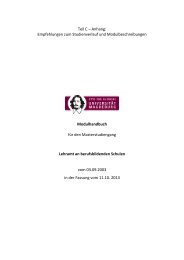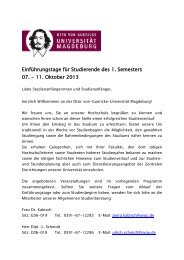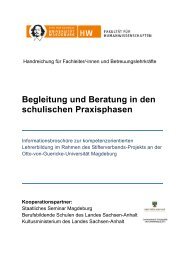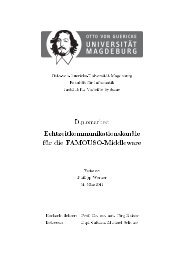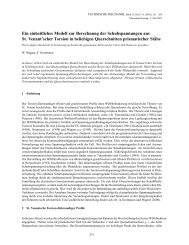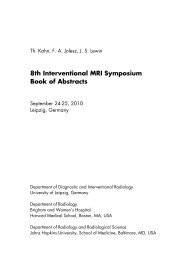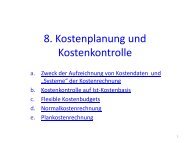Counting lattice animals: A parallel attack
Counting lattice animals: A parallel attack
Counting lattice animals: A parallel attack
Create successful ePaper yourself
Turn your PDF publications into a flip-book with our unique Google optimized e-Paper software.
Journal of Statistical Physics, Vol. 66, Nos. 1/2, 1992<br />
<strong>Counting</strong> Lattice Animals: A Parallel Attack<br />
Stephan Mertens 1 and Markus E. Lautenbacher 2<br />
Received July 1.5, 1991<br />
A <strong>parallel</strong> algorithm for the enumeration of isolated connected clusters on a<br />
regular <strong>lattice</strong> is presented. The algorithm has been implemented on 17 RISCbased<br />
workstations to calculate the perimeter polynomials for the plane<br />
triangular <strong>lattice</strong> up to clustersize s = 21. New data for perimeter polynomials<br />
D s up to D21, total number of clusters gs up to g22, and coefficients b~ in the<br />
low-density series expansion of the mean cluster size up to b21 are given.<br />
KEY WORDS: Cluster enumeration; <strong>lattice</strong> statistics; perimeter polynomials;<br />
<strong>parallel</strong> algorithms.<br />
1. INTRODUCTION<br />
Power series expansions in <strong>lattice</strong> statistics require the enumeration of<br />
finite connected clusters ("<strong>lattice</strong> <strong>animals</strong>" or "polyminoes"). The classical<br />
site percolation problem (*) considered here is a standard example. If p<br />
denotes the probability that a <strong>lattice</strong> site is occupied, the mean number<br />
(per <strong>lattice</strong> site) of connected clusters of occupied sites with size s is given<br />
by<br />
ns(p) = ~ gstpS(1- p)' =: p SD~.(q) (1)<br />
t<br />
with q = 1 -p. In the above equation gst denotes the number of possible<br />
clusters with size s and perimeter t and D,(q) is usually termed the<br />
perimeter polynomial. The perimeter polynomials comprise a considerable<br />
amount of information about the percolation problem. Ds(1 ) = :gs gives the<br />
total number of s-clusters per <strong>lattice</strong> site, for example, and the low-density<br />
series expansion of the mean cluster size S(p)= p-1 ~sSZns can easily be<br />
calculated from the coefficients g~,.<br />
Universit~it G6ttingen, lnstitut fiir Theoretische Physik, D-3400 G6ttingen, Germany.<br />
2 Technische Universit~it Mfinchen, Physik Department T30, D-8046 Garching, Germany.<br />
669<br />
0022-4715/92/0100-0669506.50/0 9 1992 Plenum Publishing Corporation
670 Mertens and Lautenbacher<br />
Quantities like S(p) show nonanalytic behavior at the percolation<br />
threshold Pc. To learn something about the location and the nature of such<br />
singularities from series expansions, one has to know as many coefficients<br />
as possible. ~2) To obtain series of reasonable length, the calculation of the<br />
g,t's, i.e., the enumeration of <strong>lattice</strong> <strong>animals</strong>, has to be put on a computer.<br />
Every enumeration algorithm, however, has to cope with the exponential<br />
growth of the number of <strong>lattice</strong> <strong>animals</strong> with cluster size s: The time<br />
required for a complete enumeration of <strong>lattice</strong> <strong>animals</strong> up to a size s grows<br />
roughly like ~2 s, where 2 is somewhat below the coordination number of<br />
the <strong>lattice</strong>. This exponential growth limits the easily reachable size very<br />
soon and calls for highly efficient algorithms.<br />
Based on the "shadow" method developed by Sykes, (3) Martin (4)<br />
described an algorithm which considerably reduces the maximum cluster<br />
size to be enumerated. The method proposed by Sykes, however, applies<br />
only to bipartite <strong>lattice</strong>s and in addition requires large amounts of fast<br />
computer memory.<br />
On the other hand, the brute-force enumeration of <strong>lattice</strong> <strong>animals</strong> by<br />
direct counting can deal with any <strong>lattice</strong> type and its memory requirements<br />
can be neglected. However, whether this approach can give useful results<br />
despite exponential growth in computer time crucially depends on its<br />
effective implementation on a computer.<br />
It is the purpose of this paper to show that calculating the perimeter<br />
polynomials by brute-force enumeration can indeed be very efficient, since<br />
the counting algorithm can be perfectly <strong>parallel</strong>ized. With its low storage<br />
requirements and its <strong>parallel</strong> nature the algorithm is well suited for<br />
medium-sized workstations which are becoming increasingly available at<br />
research institutes. E.g., for this study we used 17 RISC-based workstations<br />
in <strong>parallel</strong> to obtain three new perimeter polynomials for the (nonbipartite)<br />
plane triangular <strong>lattice</strong>.<br />
The outline of the paper is as follows: In the second section we give<br />
a brief description of how to <strong>parallel</strong>ize the counting algorithm proposed<br />
by MertensJ 5) The third section contains some remarks about the performance<br />
of the algorithm and a brief discussion of some aspects of the<br />
implementation. The fourth section comprises the results obtained for the<br />
plane triangular <strong>lattice</strong> in terms of three new perimeter polynomials.<br />
2. THE PARALLEL ALGORITHM<br />
Based on ideas of Martin (6) and Redelmeier, (7) Mertens ~5) presented an<br />
efficient algorithm for the enumeration of <strong>lattice</strong> <strong>animals</strong>. It recursively<br />
generates all clusters up to a given size s .... i.e., given any s-cluster, the<br />
algorithm builds all (s + 1)-clusters by adding one new cluster site. If all
<strong>Counting</strong> Lattice Animals: A Parallel Attack 671<br />
possible (s+l)-clusters with this particular s-cluster "parent" are<br />
generated, a new s-cluster has to be found which again serves as parent for<br />
a new generation of (s + 1)-clusters. This leads to a depth-first traversal of<br />
a "family tree" of all clusters. Each child cluster in the tree consists of its<br />
parent plus one new cluster site. This new cluster site has to be chosen so<br />
that no older brother or ancestor's older brother in the tree contains it.<br />
This is to ensure that every node in the tree is different from every other,<br />
i.e., every cluster is generated exactly once. The information about which<br />
sites are available for younger brothers and their descendants has to be<br />
passed from every node to its offspring and its younger brothers. The way<br />
this is done is crucial for the performance of the algorithm.<br />
To explain why it can be <strong>parallel</strong>ized, we give here only a simplified<br />
description of the algorithm, not going into details, like the important concept<br />
of "blocked" sites and efficient data structures (see ref. 5). The sites<br />
which are available for a node's offspring and younger brothers are coded<br />
in the "untried set." The following routine works, given such an untried set,<br />
the size s of the cluster to be generated, and the perimeter t of the parent<br />
(s-1)-cluster. The steps 1 ..... 4 are then repeated until the untried set is<br />
exhausted. Each iteration generates a child of the parent and each recursion<br />
all offspring of that child.<br />
1. Remove an element from the untried set.<br />
2. Determine "free" neighbors of this point; nn := number of these<br />
new neighbor sites.<br />
3. Count new cluster: Increase g,,t+ nn-1 by one.<br />
4. If s
672 Mertens and Lautenbacher<br />
of subtasks, the problem of <strong>lattice</strong> animal enumeration considered here is<br />
one of the rare cases where the simultaneous use of N processing units<br />
reduces the required time by a factor N, since no interprocess communication<br />
is needed at all. Therefore we do not even need a truly <strong>parallel</strong> computer<br />
architecture, but instead can distribute the independent subtasks on<br />
several ordinary standalone workstations.<br />
In practice we proceed as follows; We choose an So with a moderate<br />
number of clusters, say s o = 8 with 16,689 clusters on the plane triangular<br />
<strong>lattice</strong> (see Table III). If we have N computers at our disposal, we group<br />
these clusters in N groups of no = [16,689/N] clusters each and associate<br />
one group with each computer. For convenience we choose these groups<br />
according to the order in which the So-Clusters are generated in building up<br />
the family tree: The first no So-Clusters belong to the first group, the second<br />
no So-Clusters to the second group, and so on. Every computer explores the<br />
family tree up to size So, numbering the So-Clusters according to their order<br />
of appearance. 3 If an So-Cluster belongs to the group with which the computer<br />
is associated, the offspring of this cluster is explored to full depth, i.e.,<br />
s = s .... and the corresponding values of the g/s are written into a file.<br />
After all jobs have been completed, one simply adds corresponding<br />
coefficients g,t calculated on different computers to get the final result.<br />
The only synchronization required by this <strong>parallel</strong> organization is to<br />
tell each job which part of the so-generation has to be explored to full<br />
depth. But once the job has been started, no further communication with<br />
other jobs is necessary. This facilitates the use of completely independent<br />
computers. For example, the results presented here have been found in this<br />
way using workstations from different local clusters in G6ttingen and<br />
Munich.<br />
3. PROGRAMMING ASPECTS AND PERFORMANCE<br />
We think it is worthwhile to spend a few words on how the actual<br />
implementation of the algorithm was done. Since CPU time obviously is<br />
the bottleneck in <strong>lattice</strong> animal enumeration, improving the efficiency of<br />
the code as much as possible is a major and mandatory task when putting<br />
the algorithm on computer. The enumeration algorithm itself together with<br />
a simple (non<strong>parallel</strong>) FORTRAN implementation has already been<br />
described by Mertens elsewhere. (5) The program we used here was written<br />
in the C programming language, since the recursive formulation of the<br />
3 Since for So = 8 we have gs0 ~ 16,689, this repeated initial tree exploration causes negligible<br />
overhead, as can be seen form the average cluster counting rate of z = 2.7 x 105 clusters/sec<br />
in Table I.
<strong>Counting</strong> Lattice Animals: A Parallel Attack 673<br />
Table I. Generating Rates in Units of clusters/second on Various UNIX<br />
Workstations ~<br />
Platform SS 1 DS 3100 SS 2 HP 720<br />
<strong>Counting</strong> rate 2.45 x 10 s 2.88 x 105 5.11 x 105 8.12 x 105<br />
a The actual data acquisition was done on machines of type DEC station 3100 and Sun<br />
SPARCstation 1 only. SS, DS, and HP stand for Sun SPARCstation, DEC station, and<br />
Hewlett-Packard, respectively.<br />
Table II.<br />
Perimeter Polynomials D19, D2o, and D21 for the Plane Triangular<br />
Lattice a<br />
t 1 = 19 s=20 s=21<br />
18 1 0 0<br />
19 198 42 6<br />
20 3273 1449 507<br />
21 31288 16461 8292<br />
22 206904 134598 793309<br />
23 1138098 820623 563106<br />
24 5159312 4207833 3226522<br />
25 20570076 18503823 15633920<br />
26 72477567 71501994 66567108<br />
27 228644072 248501115 251246774<br />
28 653800881 776333631 858205000<br />
29 1687724526 2210940684 2661156060<br />
30 3965625385 5734957758 7545172940<br />
31 8449683798 13584271758 19621212282<br />
32 16312020225 29414551056 46836042306<br />
33 28486601108 58079623302 102711592570<br />
34 44734046784 104448199773 206762868636<br />
35 62841331056 170528427444 381403939182<br />
36 78293701534 251442517179 643210904138<br />
37 85253400810 332825218725 988314164230<br />
38 79474311348 391705437144 1376151103032<br />
39 61347762286 403694823051 1724915125136<br />
40 36878757573 356544784128 1925965285922<br />
41 15297106452 260634432204 1885718879538<br />
42 3262576960 148150385331 1583043419972<br />
43 0 58016840826 1099195790960<br />
44 0 11669119236 592621285797<br />
45 0 0 219802218854<br />
46 0 0 41828064480<br />
a Perimeter polynomials for smaller values of s can be found in refs. 5, 8, and 9.
674 Mertens and Lautenbacher<br />
algorithm does not fit nicely into a non-recursive language like<br />
FORTRAN, and the UNIX operating system clearly favors C. After the<br />
program had been written, we used the various profiling tools available to<br />
locate the "hotspots" in our code where most of the execution time was<br />
spent. These "hotspots" were optimized by standard techniques, such as<br />
explicitly unrolling loops and if-then-else structures. Then in a refined<br />
profiling analysis we searched for the handfull of variables accessed most,<br />
in our case certain array indices used to address perimeter polynomial<br />
coefficients gs,. We declared some of these variables to be of storage class<br />
"register." Thus, there variables would be kept in one of the CPU's register<br />
during the whole calculation instead of being swapped from and to the<br />
memory everytime they were accessed. Finding out the optimal choice and<br />
number of "register" variables by trial-and-error after explicit code un-<br />
Table III. Total Number gs of Clusters<br />
Grouped by Sites<br />
on the Plane Triangular Lattice a<br />
s<br />
gs<br />
1 1<br />
2 3<br />
3 11<br />
4 44<br />
5 186<br />
6 814<br />
7 3652<br />
8 16689<br />
9 77359<br />
10 362671<br />
11 1716033<br />
12 8182213<br />
13 39267086<br />
14 189492795<br />
15 918837374<br />
16 4474080844<br />
17 21866153748<br />
18 107217298977<br />
19 527266673134<br />
20 2599804551168<br />
21 12849503756579<br />
22 63646233127758<br />
a g21 and g22 are new. g2o has been derived recently<br />
by Sykes and Flesia (1I) using older enumeration<br />
data and combinatorial arguments. Their value is<br />
confirmed by our direct enumeration.
<strong>Counting</strong> Lattice Animals: A Parallel Attack 675<br />
rolling, we were able to achieve an overall performance increase of 40 % in<br />
terms of counted clusters per second relative to the nonoptimized version<br />
of the program. Having in mind the overall computer resource consumption<br />
of the present <strong>lattice</strong> animal study (see discussion below), we think the<br />
time that went into program optimization was well spent after all.<br />
To give some explicit ratings on program performance, we have<br />
compiled in Table I the cluster generating rates per second as measured on<br />
a number of workstations to which we had access. However, actual calculations<br />
that went into the present <strong>lattice</strong> <strong>animals</strong> data were only done on two<br />
of them, the Sun SPARCstation 1 and the DEC station 3100, both of<br />
which are machines based on modern RISC technology. With the total<br />
number of clusters counted up to a maximum cluster size of S .... = 21<br />
being gtot = 16111290471381 and an average generating rate of p ~ 2.7 x 105<br />
clusters/sec (see Tables III and I, respectively) one readily derives a CPU<br />
Table IV. Coefficients for the<br />
Expansion of s( p) = ~,rbrp r ~<br />
r<br />
br<br />
1 6<br />
2 18<br />
3 48<br />
4 126<br />
5 300<br />
6 750<br />
7 1686<br />
8 4074<br />
9 8868<br />
10 20892<br />
11 44634<br />
12 103392<br />
13 216348<br />
14 499908<br />
15 1017780<br />
16 2383596<br />
17 4648470<br />
18 11271102<br />
19 20763036<br />
20 52671018<br />
21 91377918<br />
a b2 ~ and b21 are new to us; hi9 has again<br />
been calculated recently by Sykes and<br />
Flesia Ill) using combinatorics and is confirmed<br />
by our direct enumeration.<br />
822/66/I-2-43
676 Mertens and Lautenbacher<br />
time consumption of r = gtot/P "~ 6.44 x 107 sec ~ 746 days ~ 2.04 years for<br />
the whole study. By splitting the complete task of cluster counting into<br />
smaller independent ones as described in Section 2 and running the subtasks<br />
on about 17 different workstations simultaneously, we were able to<br />
bring down the time necessary to complete the study by more than one<br />
order of magnitude, to a still large but bearable z ~ 44 says. In reality, the<br />
complete enumeration was finished in less than 2 months.<br />
4. RESULTS<br />
Table II shows the perimeter polynomials O19 , D2o, and D21 for the<br />
plane triangular <strong>lattice</strong> which are new to us. Perimeter polynomials for<br />
smaller values of s can be found in refs. 5, 8, and 9. We have used our data<br />
to calculate the total number g, of s-clusters (Table III) and the coefficients<br />
br of the low-density series expansion of the mean cluster size S(p)=<br />
~,r brP r (Table IV). The knowledge of the perimeter polynomials up to size<br />
Smax allows the calculation of gs up to s -~ Smax + 1 and the series expansion<br />
of S up to order Srnax. For <strong>lattice</strong>s for which the low-density expansion of<br />
the mean number of clusters<br />
K(p)=~krp r (2)<br />
r<br />
is available through k .... --2, the perimeter polynomials of size Smax determine<br />
both b .... +1 and g .... + 2 .(1~ This fact has been exploited by Sykes and<br />
Flesia (m to obtain g20 and b19. Their values have been confirmed by our<br />
direct enumeration.<br />
It is interesting to note that the coefficients br in the expansion of S(p)<br />
for the triangular <strong>lattice</strong> keep growing monotonically with r. This should<br />
be compared to the corresponding coefficients br of the simple square<br />
<strong>lattice</strong>, which oscillate for larger values of r. (5)<br />
5. CONCLUSIONS<br />
In this study we have shown that the enumeration of <strong>lattice</strong> <strong>animals</strong><br />
can be organized in a <strong>parallel</strong> algorithm which reduces the necessary time<br />
by a factor N, where N is the number of available computers. This is the<br />
maximum improvement that can be expected from a <strong>parallel</strong> algorithm<br />
using N processors, since in the form presented here the algorithm requires<br />
no interprocess communication at all. Facing the exponentially growing<br />
complexity of the enumeration problem, this might be regarded as only a<br />
modest advance. Nevertheless the proposed algorithm already yields the
<strong>Counting</strong> Lattice Animals: A Parallel Attack 677<br />
maximum speedup possible when trying to <strong>attack</strong> the problem with<br />
multiple computers instead of one computer. Along these lines one simply<br />
cannot do better. Further improvement calls for different methods.<br />
The relevance of larger and larger exact enumerations may well be<br />
questioned, of course. However, besides the pure academic motivation<br />
of knowing still a few perimeter polynomials more, there is hope that if<br />
reaching large enough values of cluster size s exact enumerations like this<br />
one can give valuable guidance in the search for some analytic asymptotic<br />
theory of <strong>lattice</strong> <strong>animals</strong> which, once found, surely will supplement exact<br />
enumerations with a deeper understanding of <strong>lattice</strong> animal growth. Also,<br />
numerical estimates for scaling corrections become more reliable with the<br />
knowledge of additional perimeter polynomials.<br />
It should be mentioned, however, that our <strong>parallel</strong> algorithm in the<br />
present formulation is restricted to the calculation of perimeter polynomials.<br />
A more general method for the effective generation of series expansions,<br />
the "no-free-end" method, can be found in ref. 12.<br />
In addition to the enumeration results presented, this paper can be<br />
regarded as another example of how to <strong>attack</strong> a research problem in<br />
computational physics using only medium-sized workstations instead of the<br />
expensive CPU time of sometimes rather user-unfriendly and little flexible<br />
mainframes. With prices falling, the number of workstations available is<br />
expected to increase rapidly in the future. However, a considerable<br />
percentage of them probably will be used only interactively for tasks like<br />
text-processing, graphics, or e-mail, thus leaving the powerful CPU almost<br />
idle. We have demonstrated here that on such machines a long-running,<br />
low-priority background job which usually is not even recognized by the<br />
average user is able to pick up enough CPU time to yield research results<br />
in a reasonable amount of time if the whole project is coordinated properly<br />
by running similar jobs on other idle workstations. We believe that along<br />
these lines the computational power of the growing number of workstations<br />
may well be used to <strong>attack</strong> a number of problems which are up to<br />
now in the realm of mainframes and supercomputers.<br />
ACKNOWLEDGMENTS<br />
We would like to thank D. Stauffer for his helpful suggestions on the<br />
manuscript. All calculations have been performed on workstations of the<br />
Institute of Numerical and Applied Mathematics in G6ttingen and the<br />
Institute for Theoretical Physics of the Physics Department at Technical<br />
University Munich. One of us (S.M.) appreciates the support of the local<br />
system administrator G. Siebrasse.
678 Mertens and Lautenbacher<br />
REFERENCES<br />
1. D. Stauffer, Introduction to Percolation Theory (Taylor & Francis, London, 1985), and<br />
references therein.<br />
2. C. Domb and M. S. Green, eds., Phase Transitions and Critical Phenomena, Vol. 3<br />
(Academic Press, 1974).<br />
3. M. F. Sykes, J. Phys. A Math. Gen. 19:1007 1025, 1027-1032, 2425-12429, 2431 2437<br />
(1986).<br />
4. J. L. Martin, 3. Stat. Phys. 58:749 (1990).<br />
5. S. Mertens, J. Stat. Phys. 58:1095 (1990).<br />
6. J. L. Martin, in Phase Transitions and Critical Phenomena, Vol. 3, C. Domb and M.S.<br />
Green, eds. (Academic Press, 1974), pp. 97-112; see S. Redner, J. Stat. Phys. 29:309 (1981)<br />
for a FORTRAN program.<br />
7. D. H. Redelmeier, Distr. Math. 36:191 (1981).<br />
8. M. F. Sykes and M. Glen, J. Phys. A Math. Gen. 9:87 (1976).<br />
9. A. Margolina, Z. V. Djordjevic, D. Stauffer, and H. E. Stanley, Phys. Rev. B 28:1652<br />
(1983).<br />
10. M. F. Sykes and M. K. Wilkinson, J. Phys. A 19:3415 (1986).<br />
11. M. F. Sykes and S. Flesia, J. Stat. Phys. 63:487 (1991).<br />
12. J. Adler, Y. Meir, A. Aharony, A. B. Harris, and L. Klein, 3. Stat. Phys. 58:511 (1990).<br />
Communicated by D. Stauffer



